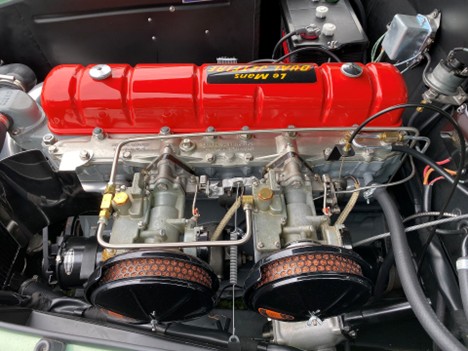by A. Wayne Ferens
Images Courtesy of the Ferens Collection
Published 12.25.2024
 The Pinin Farina steel body of the Nash-Healey (Ferens Collection)
The Pinin Farina steel body of the Nash-Healey (Ferens Collection)
Today, I like to say “opinions are like cell phones -- everybody has one.” Over the years, many have asked the same question: "Who produced the first post-war sports car?" And the answer is still the same. It wasn't the Crosley Hot Shot. It wasn't the Chevrolet Corvette, the Kaiser Darrin or the Ford Thunderbird. The Answer? The early 1950s Nash-Healey was the first post-war sports car from a major American automaker. That major automaker would be the Nash Kelvinator Corporation in Detroit, Michigan.
Charles W. Nash was hired by William C. Durant in 1910 to run the Buick operation at General Motors. Nash hired Walter P. Chrysler in 1911 to help him grow the Buick brand, but was let go by Durant in 1915 after he returned to GM.
 The Nash Motors Company in Kenosha WI (Ferens Collection)
The Nash Motors Company in Kenosha WI (Ferens Collection)
The Nash Motors story begins soon after when Nash purchased the Thomas B. Jeffery Company, a small car manufacturer producing the 'Rambler' in Kenosha, Wisconsin and renamed it. Over the years, Nash made several more acquisitions and mergers: in 1924, Nash acquired Lafayette Motors and in 1937 merged with the Kelvinator Appliance Company. Kelvinator's George W. Mason was soon made CEO of Nash Motors when Charles Nash retired. Nash passed away in 1948 at the age of 84.
After the war, Nash was struggling to maintain its 4th position after the big three - GM, Ford and Chrysler having 78 percent of the market. The idea of a sports car was discussed after George Mason met then-British sports car maker and race driver Donald Healey in 1949 while crossing the Atlantic on the Queen Elizabeth ocean liner. Before reaching shore, Mason agreed to financing a sports car using a modified version of the reliable Nash Ambassador in-line cast iron, 6-cylinder, OHV 234.8 cu. in. engine and three-speed manual transmission with Borg-Warner overdrive. Nash would supply the powertrain to Healey.
Healey in England would modify the engine using a lighter, higher compression aluminum cylinder head and twin SU (44mm) side draft carburetors. Power would be increased from 112 hp to 125 hp. Healey would also use their modified “Silverstone” chassis that was widened and reinforced box-sectioned ladder-type steel frame. The Silverstone independent coil spring front suspension was maintained, but the Healey rear suspension was replaced with the Nash-supplied torque-tube and live axle. Lateral location of the axle was handled by a Panhard rod.
 The 253 cu.in., 140 hp Le Mans Dual Jetfire engine now with twin Carter carbs. The Le Mans engine was available in both coupe and convertible. (Ferens Collection)
The 253 cu.in., 140 hp Le Mans Dual Jetfire engine now with twin Carter carbs. The Le Mans engine was available in both coupe and convertible. (Ferens Collection)
The aluminum body was Healey designed, but fabrication was outsourced to Panelcraft Sheet Medal Company in Birmingham, England. Healey was responsible for the car’s final assembly that included a Nash grill, bumpers, drum brakes, full chrome wheel covers on steel wheels with 15 inch white wall tires. The interior featured luxurious leather upholstery, foam rubber cushions, an adjustable steering wheel, and a cigarette lighter. The Nash-Healey would be sold through Nash's 1,800 U.S. dealerships.
 The Nash-Healey roadster at the February 1951 Chicago Auto Show. (Ferens Collection)
The Nash-Healey roadster at the February 1951 Chicago Auto Show. (Ferens Collection)
The roadster debuted at the February 1951 Chicago Auto Show with only two colors available, Champagne Ivory and Sunset Maroon. The car was expensive with a sticker price of $3,767. 104 units were produced in 1951.
Over the next several years, the Nash-Healey went through several changes that included a revised steel body designed and assembled in Italy by Pinin Farina. The front received a new grill incorporating inboard headlights. The rear fenders distinct character lines ended with small tailfins in the rear. A one-piece curved windshield replaced the two-piece flat windshield on the previous model.
The Pinin Farina steel body was actually lighter due to careful engineering and the use of aluminum for the hood, trunk and dashboard. Engine displacement was increased to 253 cu. in. and horsepower increased to 140 hp. 150 units were produced in 1952.
 The Nash-Healey Le Mans coupe
The Nash-Healey Le Mans coupe
1953 saw the introduction of the Nash-Healey Le Mans coupe in reference to the previous racing exploits at the Circuit de la Sarthe. The coupe and roadster, now advertised as a convertible, were produced in 1953 (total 162 units), and 1954 (total 90 units).
On May 1, 1954, Nash-Kelvinator merged with the Hudson Motor Car Company, forming the new American Motors Corporation (AMC). Nash became a division of AMC and was faced with limited resources for developing new models, marketing and promotions. The made-in-Italy Nash-Healey, now priced near $6,000, was discontinued in August 1954.
 A classic red sports car! (Ferens Collection)
A classic red sports car! (Ferens Collection)
The Nash-Healey was well-made, beautiful, fast and practical. Tom McCahill, after testing the Nash-Healey for Mechanix Illustrated Magazine, summed it up, saying: "Of all the sports cars I have ever tested -- and I have driven most of them -- I would just as soon own a Nash-Healey as any on the road."
Bibliography:
Mechanix Illustrated, 1951.
Classic Cars, October 1978.
Cars & Parts, October 1974.
Nash-Healey Owners Club.



